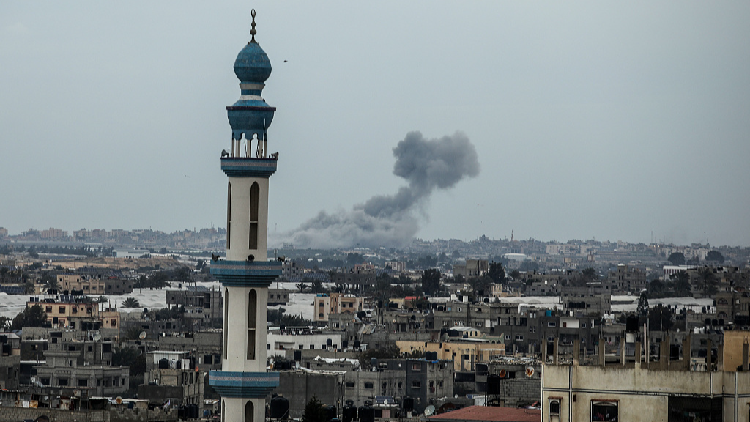Fighting between Israel and Hamas entered its fifth month on Wednesday amid high hopes for a truce deal that has the potential to end the conflict once and for all.
The U.S., Qatar and Egypt have been trying to broker a common ground that both Israel and Hamas can accept as conditions for a ceasefire in the Gaza Strip, much of which has been ravaged by Israel’s military offensive.
On Tuesday, Hamas said it had given a “positive” response to an offer provided by the mediators, who had earlier consulted Israel on the proposal. The prospect of a truce has not reached this high since a previous seven-day ceasefire ended in late November, but Hamas has previously said it wants more guarantees that the deal could put an end to Israel’s military operations.
The proposal reportedly envisions a truce of at least 40 days when Hamas would free the civilians among the remaining hostages it is holding, followed by later phases to hand over soldiers and bodies.
The latest round of the conflict in Gaza was triggered after Hamas fighters stormed southern Israel in a surprise attack on October 7, killing close to 1,200 people and taking over 240 hostages, more than 100 of whom would later be released.
<img src='https://news.cgtn.com/news/2024-02-07/Hopes-of-a-Gaza-truce-deal-as-Israel-Hamas-conflict-enters-5th-month-1r07V7WpVuw/img/6cb057a42b6045dfa64bb029a3d1bac0/6cb057a42b6045dfa64bb029a3d1bac0.png' alt=''
Fighting in the Palestinian enclave has grown more intense over the past month, with Israeli tanks advancing for two weeks in Khan Younis, a southern Gaza city where Israel says it has defeated the militant group, and Hamas fighters becoming more active in their resistance against Israeli forces, which suffered their biggest single-day losses on January 23 since the start of its invasion into the Palestinian enclave.
Israel’s military operations in the northern part of the strip have diminished following its seizure of the area during the initial two months of its offensive, raising hopes for the return of displaced civilians to their homes – a prospect the Israeli army has signaled it will not allow at this stage.
Fighting has, however, resurged in Gaza City, the main northern city, in recent days in what the Israeli army says is a bid to prevent Hamas from rebuilding its capabilities.
In the meantime, Israel has warned of a new ground incursion into Rafah, a small city on the southern border with Egypt. This area is currently home to over half of Gaza’s 2.3 million residents, many of whom are residing in makeshift tents, having sought refuge in Rafah after fleeing from other parts of the strip.
Israeli Prime Minister Benjamin Netanyahu, visiting troops on Monday, said Israeli forces had eliminated or injured more than half of Hamas’ combat units and would carry on until “total victory.”
Netanyahu, whose approval rate has slid to rock bottom, has been focusing his struggle for political survival on appealing to the right. The prime minister has rejected the possibility of Palestinian statehood despite being pushed for peace talks by his allies in Washington.
Senior Hamas official Sami Abu Zuhri dismissed Netanyahu as “playing the game of making delusional victories” in the face of continued resistance.
Spread of the conflict
Israel’s military action has set off a surge in attacks by Iran-backed groups across the Middle East in solidarity with the Palestinians. Also among the targets were U.S. troops based in Syria, Iraq and Jordan, as Washington’s backing for Israel is viewed by Tehran, as well as by many of these groups, as an “evil scheme” that needs to be foiled.
The U.S. military on Friday initiated a series of airstrikes allegedly targeting Iranian forces and Tehran-aligned fighters in Iraq and Syria in response to a drone attack in Jordan that resulted in the deaths of three U.S. soldiers in late January.
In and around the Red Sea, Yemen’s Houthi movement has kept launching missile and drone strikes on U.S. warships and container vessels, which it says have links to Israel. The U.S. and the UK have struck Houthi targets in Yemen in a bid to curtail the group’s strength.
Clashes between Israeli troops and Hezbollah fighters have persisted on the Israeli-Lebanese border, with more than 240 people, including civilians, killed on both sides combined. The Israeli military said last week it had attacked 3,400 Hezbollah targets in Lebanon, including 120 border surveillance outposts, 40 caches of missiles and other weaponry, and more than 40 command centers.
Also on Friday, the Israeli army said its defense system “successfully intercepted a surface-to-surface missile that approached Israeli territory in the area of the Red Sea,” with the Houthis claiming they had fired missiles towards Israel.
(Infographic by Sun Yiwen)
(Cover: A picture taken from Rafah in the southern Gaza Strip shows smoke rising over buildings in Khan Younis following Israeli bombardment of the Gaza Strip, February 6, 2024. /CFP)











+ There are no comments
Add yours